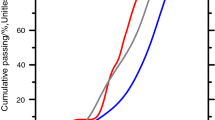Abstract
Study was focused upon formulating sodium polyphosphate-modified fly ash/calcium aluminate blend (SFCB) geothermal well cements with advanced anti-carbonation and anti-acid corrosive properties. At a low hydrothermal temperature of 90°C, to improve these properties, we investigated the effectiveness of various calcium aluminate cement (CAC) reactants in minimizing the rate of carbonation and in abating the attack of H2SO4 (pH ∼ 1.6). We found that the most effective CAC had two major phases, monocalcium aluminate (CA) and calcium bialuminate (CA2), and a moderate CaO/Al2O3 ratio of 0.4. The reaction between sodium polyphosphate (NaP) and CA or CA2 at room temperature led to the formation of amorphous dibasic calcium phosphate hydrate and anionic aluminum hydroxide caused by the decalcification of CA and CA2. When SFCB cement made with this CAC was exposed to 4% NaHCO3-laden water at 90°C, some carbonation of the cement occurred, forming calcite that was susceptible to the reaction with H2SO4. This reaction resulted in the deposition of gypsum gel scales as the acid corrosion product on the cement surfaces. The scale layer clinging to the cement protected it from further corrosion. Under such protection, the amorphous dibasic calcium phosphate hydrate → crystal hydroxyapatite and anionic aluminum hydroxide → crystal boehmite phase transitions were completed in acid solution. Meanwhile, the further chemical and hydration reactions of NaP with fly ash led to the formation of additional crystalline Na-P type zeolite phases. Thus, we propose that passivation of the surface of the cement by deposition of gypsum, following the formation of these reaction products, which are relatively inert to acid, are the acid corrosion-inhibiting mechanisms of the SFCB cements.
Similar content being viewed by others
References
T. SUGAMA, N. R. CARCIELLO, T. M. NAYBERG and L. E. BROTHERS, Cem. Concr. Res. 25 (1995) 1305.
T. SUGAMA, Adv. Cem. Res. 9 (1997) 65.
Idem., Cem. Concr. Res. 26 (1996) 1661.
L. WEBER, E. EMERSION, K. HARRIS and L. E. BROTHERS, Geothermal Resource Council Transaction 22 (1998) 25.
T. SUGAMA, L. WEBER and L. E. BROTHERS, Cem. Concr. Res. 29 (1999) 1969.
F. G. R. GIMBLETT, “Inorganic Polymer Chemistry” (Butterworths, London, 1963) p. 336.
C. E. HARVIE and J. H. WEARE, Geochim. Cosmochim. Acta. 44 (1980) 981.
Z. JIN and J. HEO, J. Mater. Sci. Lett. 17 (1998) 633.
E. J. REARDON, Cem. Concr. Res. 20 (1990) 175.
D. M. ROY, M. R. SILSBEE and D. WOLFE-CONFER, in “Specialty Cements with Advanced Properties,” edited by B. E. Scheetz, A. G. Landers, I. Odler and H. Jennings (Materials Research Society, MRS 1990) Vol. 179, p. 203.
R. A. NYQUIST and R. O. KAGAL, “Infrared Spectra of Inorganic Compounds” (Academic Press, New York, 1971) p. 79.
T. SUGAMA, M. ALLAN and J. M. HILL, J. Amer. Ceram. Soc. 75 (1992) 2076.
P. H. COLOMBAN, J. Mater. Sci. Lett. 7 (1988) 1324.
G. K. PRIYA, P. PADMAJA, K. G. K. WARRIER, A. D. DAMODARAN and G. ARULDHAS, ibid. 16 (1997) 1584.
D. E. C. CORBRIDGE and E. J. LOWE, J. Chem. Soc. (1954) 269.
R. A. NYQUIST and R. O. KAGAL, “Infrared Spectra of Inorganic Compounds” (Academic Press, New York, 1971) p. 269.
L. J. BELLANY, “The Infra-Red Spectra of Complex Molecules” (Chapman and Hall, London, 1975) p. 386.
M. NAGAI, T. SAEKI and T. NISHINO, J. Amer. Ceram. Soc. 73 (1990) 1456.
Author information
Authors and Affiliations
Rights and permissions
About this article
Cite this article
Sugama, T., Brothers, L.E. & Weber, L. Calcium aluminate cements in fly ash/calcium aluminate blend phosphate cement systems: Their role in inhibiting carbonation and acid corrosion at a low hydrothermal temperature of 90°C. Journal of Materials Science 37, 3163–3173 (2002). https://doi.org/10.1023/A:1016158328024
Issue Date:
DOI: https://doi.org/10.1023/A:1016158328024




